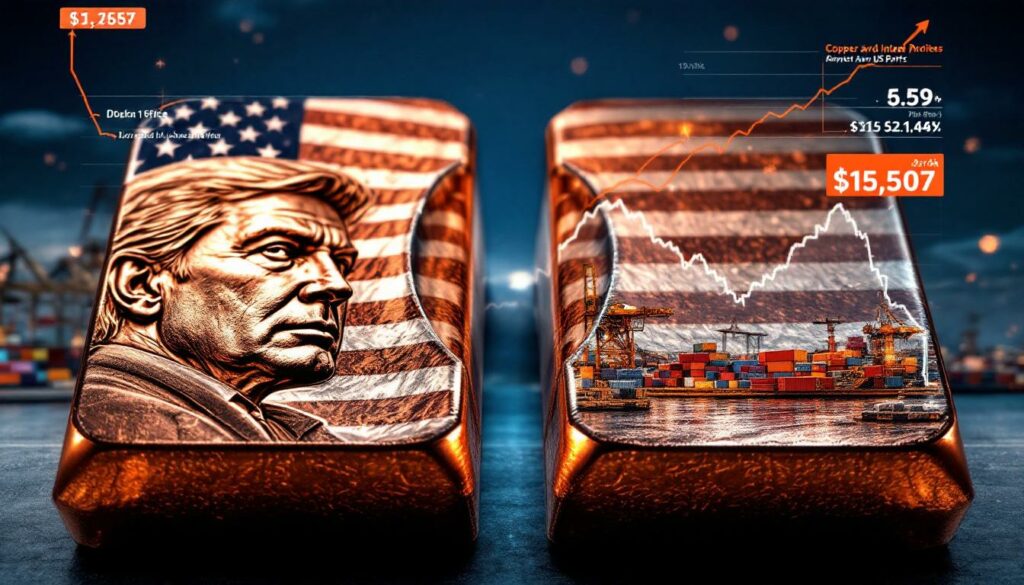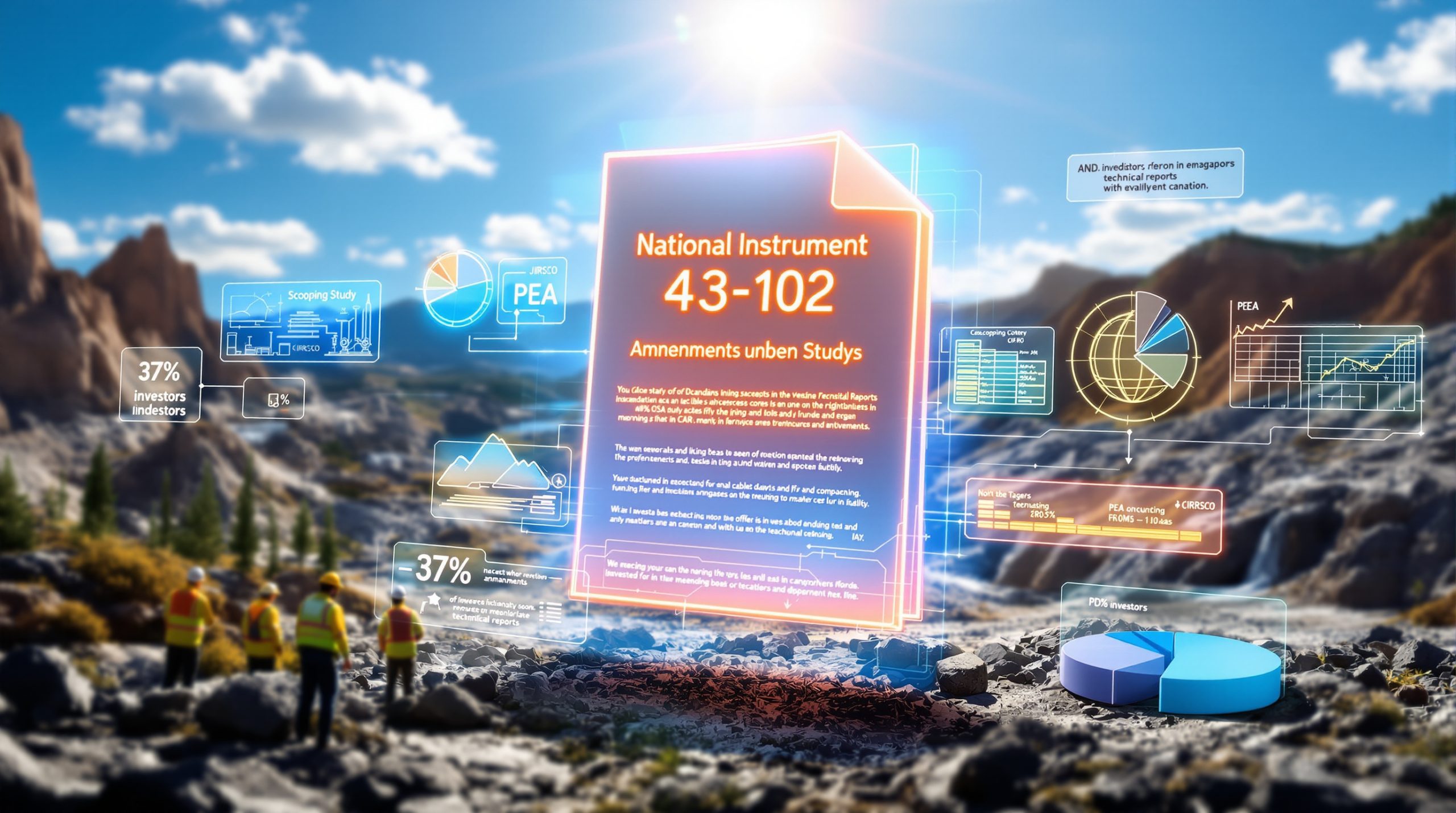Trump's Copper Tariff Threat: Impact on Global Markets and Prices
The global copper market faces a potential upheaval as former U.S. President Trump has announced intentions to implement a 50% tariff on imported copper should he return to office. This unprecedented move, with a proposed effective date of August 1, 2025, represents one of the most aggressive trade policy proposals affecting the metals sector in recent history.
Understanding Trump's Tariff Proposal
Trump's tariff proposal includes tariff letters sent to eight countries, with Brazil specifically mentioned as facing potential 50% duties on copper imports. This proposal aligns with his established pattern of protectionist trade policies, but the scale of the proposed copper tariff exceeds previous metals-focused trade actions.
The 50% rate would create an enormous price differential between U.S. and global markets, effectively redrawing global copper trade maps. Unlike previous tariff actions which typically ranged from 10-25%, this proposal would make U.S.-bound copper shipments economically unfeasible without massive price adjustments.
While the announcement lacks specific implementation details, it follows Trump's established approach of using tariffs as both economic and diplomatic leverage. The August 2025 implementation date suggests a deliberate timeline allowing for market adjustment or potential negotiation.
Potential Market Disruption Scenarios
A tariff of this magnitude would trigger cascading effects throughout global supply chains. The most immediate impact would involve the redistribution of copper flows away from the U.S. market, creating regional imbalances:
- Non-U.S. markets would likely experience supply surpluses as exporters redirect shipments
- U.S. domestic consumers would face significant price premiums and potential supply constraints
- Trading patterns would restructure around regional price disparities
- Producing countries highly dependent on U.S. exports would face economic pressure
"Increasing copper tariffs would make the spot copper market in non-U.S. regions relatively loose, thereby putting pressure on copper prices." — Shanghai Metal Market (SMM) Analysis
The tariff proposal also raises questions about retaliatory measures from affected nations. Major copper producers like Chile and Peru could respond with counter-tariffs on U.S. exports or form alternative trading blocs to protect their mining sectors from market disruption.
What Are the Immediate Market Reactions to Tariff Announcements?
Current Price Movements
The initial market response to Trump's announcement has been measured but decidedly negative, reflecting uncertainty rather than panic:
- LME copper closed at $9,660/mt, showing a marginal decline of 0.05%
- SHFE copper experienced a more significant drop of 0.74%, closing at 78,330 yuan/mt
- Trading volumes remained moderate with LME at 38,000 lots and SHFE at 35,000 lots
- Open interest stood at 279,000 lots for LME and 190,000 lots for SHFE
These figures suggest market participants are processing the information cautiously rather than rushing to reposition. The more pronounced reaction in Chinese markets may reflect concerns about broader trade tensions affecting the world's largest copper consumer.
The relatively modest price reaction also suggests the market is discounting the announcement based on implementation uncertainty and the distant effective date. Traders appear to be taking a "wait and see" approach rather than making dramatic portfolio adjustments.
Trader Sentiment and Behavior
The market psychology following the tariff announcement reveals distinct behavior patterns among different market participants:
- Downstream buyers have shown limited "buy the dip" behavior despite the price decrease
- Institutional traders are predominantly adopting a wait-and-see approach
- Producers appear reluctant to offer significant discounts, suggesting they view the tariff threat as potentially transitory
- Overall sentiment leans bearish, with risk appetite suppressed due to policy uncertainties
"Most downstream users adopted a cautious wait-and-see approach, with bearish outlook expectations influencing procurement strategies." — SMM Morning Copper Comment
This cautious approach makes strategic sense given the tariff's distant implementation date and political uncertainties. Rather than making immediate portfolio adjustments, market participants appear to be gathering information and assessing potential scenarios before committing to directional trades.
How Do Tariffs Affect Regional Copper Market Dynamics?
Non-US Markets Outlook
The proposed tariff would significantly reshape non-U.S. copper markets, potentially creating regional oversupply situations as exports divert from American buyers:
- Asian markets could see increased availability as Chilean and Peruvian producers redirect shipments
- European buyers might benefit from improved negotiating leverage with suppliers
- Price pressures would likely emerge from increased regional availability
- New trade relationships could form as producers seek stable alternative buyers
Chilean and Mexican producers are reportedly already exploring alternative market opportunities in anticipation of potential trade barriers. This proactive approach reflects lessons learned from previous trade disruptions, where early market diversification proved crucial for maintaining production volumes.
The regional rebalancing would likely favor copper consumers in non-U.S. markets, at least temporarily. Copper price insights suggest that price differentials could emerge where non-U.S. buyers access copper at discounts compared to their American counterparts, potentially creating competitive advantages in copper-intensive manufacturing sectors.
US Market Implications
For U.S. copper consumers, the tariff proposal presents significant challenges and potential restructuring requirements:
- Price increases would be inevitable for domestic consumers, with the 50% tariff likely to be partially passed through
- Supply constraints could emerge despite the tariff's intended protective effect
- Manufacturing costs would rise across copper-dependent industries like electronics, construction, and electrical infrastructure
- Pre-tariff import surge ("rush shipments") might occur as implementation date approaches
American industries heavily reliant on copper—including electrical equipment manufacturers, construction firms, and renewable energy developers—would face difficult choices between absorbing higher input costs, passing increases to customers, or seeking design alternatives that reduce copper intensity.
Domestic U.S. copper producers like Freeport-McMoRan and Rio Tinto might initially benefit from price protection, but would face pressure to increase output while managing the risk of future policy reversals. The tariff timeline suggests an 18-month window during which domestic capacity expansion decisions would need to be made.
What Are the Macroeconomic Factors Compounding Tariff Effects?
Federal Reserve Policy Considerations
The tariff proposal intersects with monetary policy concerns at a critical juncture:
- Fed minutes from June revealed divided opinions among officials regarding tariff inflation impacts
- July interest rate cut prospects have been effectively ruled out amid policy uncertainty
- Monetary tightening could potentially exacerbate economic pressure from tariff-driven price increases
- Stagflation risk emerges if tariffs drive inflation while simultaneously restricting growth
The Federal Reserve faces a challenging balancing act if tariffs create inflationary pressure while potentially slowing economic activity. The historical precedent suggests tariffs typically create modest but measurable inflationary effects while simultaneously reducing economic efficiency—a combination that complicates monetary policy decisions.
This macroeconomic uncertainty adds another layer of complexity for copper market participants already navigating supply-demand fundamentals and technical factors. The potential for compounding effects between trade policy and monetary policy creates scenario planning challenges for traders and physical market participants alike.
Global Trade Flow Adjustments
Beyond immediate price effects, the tariff would necessitate fundamental restructuring of international copper supply chains:
- Logistics patterns would shift as shipment destinations change
- Competitive advantages would realign among copper-producing nations based on tariff exposure
- Transportation costs could increase due to less efficient routing
- Environmental footprint might grow if supply chains lengthen
These adjustments would unfold gradually rather than instantly, with producers and consumers likely to proceed cautiously until policy certainty emerges. The proposed implementation date provides an adjustment window, but supply chain reconfiguration typically requires significant lead time and investment.
The copper price collapse analysis shows that the market's adaptation to these potential changes would likely mirror previous commodity market responses to trade barriers—initial disruption followed by gradual reoptimization around the new policy reality, though with efficiency losses and regional price disparities persisting.
How Might Copper Fundamentals Evolve Under Tariff Pressure?
Supply-Side Dynamics
The tariff proposal emerges against a backdrop of evolving copper supply fundamentals:
- Regional availability would improve outside the U.S. as cargo diversions increase market liquidity
- Production adjustments at major mining operations might occur gradually rather than immediately
- Project timelines for new mines could accelerate in tariff-exempt regions or domestic U.S. locations
- Stockpile management strategies would likely evolve among traders positioning for policy implementation
"Fundamentals have improved supply due to potential cargo transfers… presenting a pattern of 'expected supply easing and weak actual demand'." — SMM Analysis
The supply response would be constrained by the capital-intensive, long-lead-time nature of copper mining. Unlike manufacturing industries that can relatively quickly relocate production, copper supply chains are anchored to geological realities that limit short-term flexibility.
Existing mines have limited ability to significantly increase output without substantial investment, while new mining projects typically require 5-10 years from discovery to production. This inherent inflexibility means US tariffs impact on supply would likely persist longer in copper markets than in more adaptable commodity sectors.
Demand-Side Response
Consumer behavior adjustments would play a crucial role in determining ultimate market impacts:
- Procurement strategies are becoming increasingly cautious amid market uncertainty
- Substitution efforts may accelerate where technically feasible (aluminum alternatives in some applications)
- Regional demand shifts could emerge based on relative price advantages
- Inventory management approaches would likely become more sophisticated
The copper intensity of modern economies makes wholesale substitution difficult, particularly in critical applications like electrical conductivity, renewable energy infrastructure, and electronic components. However, price-driven engineering optimization could accelerate in price-sensitive applications, potentially creating lasting changes in copper demand patterns.
U.S. manufacturers in particular would face pressure to reevaluate copper usage where alternatives exist, potentially accelerating materials innovation while creating challenges for established production processes. This adaptation process typically unfolds over multi-year timeframes rather than immediate reactions.
What Are the Technical Market Indicators Suggesting?
Price Resistance and Support Levels
Technical analysis provides important context for understanding potential price trajectories:
- Immediate resistance appears evident in current price patterns, limiting upward movement
- Support levels are being tested as market sentiment processes the tariff announcement
- Trading ranges have narrowed amid the uncertainty, reflecting reduced risk appetite
- Volume patterns indicate cautious market participation rather than panic selling
"Copper prices will encounter resistance above today's levels" — SMM Technical Analysis
The technical picture suggests consolidation rather than immediate trend reversal, with traders establishing new range-bound strategies while awaiting further policy clarity. This technical behavior aligns with historical patterns during trade policy uncertainty, where initial reactions give way to range-bound trading until implementation details emerge.
Chart patterns indicate potential vulnerabilities to downside pressure if additional negative catalysts emerge, with key support levels being closely monitored by technical traders positioning for various policy scenarios.
Trading Strategy Considerations
Market participants are adapting strategies to navigate the uncertain environment:
- Hedging activities have increased among industrial consumers exposed to price volatility
- Arbitrage opportunities may emerge between regional markets as price disparities develop
- Timing considerations for physical delivery contracts are becoming more complex
- Risk management approaches are evolving for both producers and consumers
Professional traders are increasingly focused on spread trading strategies rather than outright directional bets, reflecting the uncertain directional outlook but increased likelihood of regional price divergences. This approach allows for capitalizing on relative value opportunities while limiting exposure to broader market direction uncertainty.
For physical market participants, contract structures are evolving to incorporate greater flexibility and optionality given the policy uncertainty. Premium/discount mechanisms are likely to gain importance as tools for managing regional price divergences resulting from trade flow disruptions.
How Might Different Stakeholders Navigate the Tariff Environment?
Strategies for Copper Producers
Mining companies and refiners face unique challenges requiring strategic responses:
- Geographic diversification of customer bases to reduce exposure to any single market
- Value-added processing investments to potentially avoid raw material tariffs
- Strategic stockpiling considerations in anticipation of policy implementation
- Collaborative approaches with downstream customers to manage transition periods
Major producers like Codelco (Chile), Southern Copper (Mexico/Peru), and Freeport-McMoRan (U.S.) face different strategic imperatives based on their production locations and customer exposures. Chilean producers in particular must balance their traditional U.S. market focus against the need for market diversification.
The extended implementation timeline provides producers with an adjustment window, but capital allocation decisions for long-lived mining assets require careful consideration of policy durability versus potential reversal under future administrations.
Approaches for Copper Consumers
Industrial users of copper are developing multi-faceted responses to the potential price and availability challenges:
- Forward purchasing to secure pre-tariff pricing for critical inventory
- Alternative sourcing exploration focused on tariff-exempt origins
- Inventory optimization to balance price risk against carrying costs
- Price pass-through strategies for end products where possible
Manufacturers in copper-intensive sectors like electrical equipment, construction, and transportation face difficult decisions about absorbing costs versus passing increases to customers. The competitive implications vary significantly based on whether competitors face similar cost pressures or benefit from different supply chain exposures.
For U.S. consumers, domestic sourcing options are constrained by limited production capacity, creating complex tradeoffs between price premium acceptance, inventory building ahead of implementation, and product redesign to reduce copper intensity.
FAQ About Copper Tariffs and Market Impact
What other countries might be affected by the proposed tariffs?
While Brazil has been specifically mentioned in the tariff letters, major copper-producing nations including Chile, Peru, and Mexico would likely be significantly affected given their export volumes to the U.S. market. Chile alone accounts for approximately 30% of global copper production and has historically maintained substantial export relationships with U.S. consumers.
The comprehensive impact would depend on whether the tariffs apply universally or include country-specific exemptions, which remains unclear from the current announcement. Historical precedent suggests selective application is possible as a negotiating tactic.
How might copper tariffs affect consumer goods prices?
Copper is an essential input in numerous consumer and industrial products:
- Electronics: Circuit boards, wiring, connectors
- Construction: Plumbing, electrical systems, HVAC equipment
- Transportation: Electric vehicles (containing 80+ kg of copper per vehicle)
- Renewable energy: Solar installations, wind turbines, transmission infrastructure
Price increases would likely be passed through the supply chain in varying degrees, potentially adding costs to everything from home appliances to electric vehicles. The impact magnitude would depend on copper content, competitive factors, and substitution possibilities in each product category.
Could tariffs lead to increased domestic copper production in the US?
While tariffs create price incentives for domestic production, copper mining development faces significant constraints:
- Development timeline: New mines typically require 5-10 years from planning to production
- Permitting challenges: U.S. mining permits often face lengthy regulatory processes
- Grade limitations: Many U.S. copper deposits feature lower grades requiring higher investment
- Capital requirements: New mines require billions in investment amid policy uncertainty
Existing U.S. operations like those in Arizona and Utah could potentially accelerate expansion plans, but meaningful production increases would likely take years rather than months to materialize. The U.S. currently produces approximately 8% of global copper supply, significantly below domestic consumption requirements.
What alternatives do manufacturers have if copper prices rise significantly?
Adaptation strategies vary by application and technical requirements:
- Aluminum substitution is possible in some electrical applications, though with approximately 70% of copper's conductivity
- Design optimization to reduce copper content through engineering improvements
- Recycling initiatives to increase utilization of secondary copper sources
- Material thickness reduction where performance requirements permit
Each alternative involves tradeoffs in performance, cost, or reliability. Critical applications with strict performance requirements—like data center power systems or medical equipment—have limited substitution options and would likely absorb price increases.
Market Outlook and Future Considerations
Short-Term Price Projections
Market indicators currently suggest a challenging near-term outlook for copper prices:
- The developing pattern of "supply easing and weak actual demand" creates downward pressure
- Price volatility will likely increase as implementation dates approach
- Regional price divergence between U.S. and international markets could develop
- Tactical trading opportunities will emerge amid the uncertainty
The most immediate effect appears to be dampened buying interest as market participants process the implications of potential policy changes. This cautious approach creates a scenario where prices may drift lower in the absence of other supportive factors, with potential for sharper moves as policy details emerge.
The prospect of pre-implementation "rush shipments" to the U.S. market could temporarily support prices in the months immediately preceding any tariff implementation, creating potential volatility windows that traders are already positioning to navigate.
Long-Term Structural Implications
Beyond immediate price effects, the tariff proposal could catalyze lasting structural changes:
- Global trade flows may permanently reshape around new economic realities
- Investment patterns in mining and processing infrastructure could shift geographically
- Pricing mechanisms and benchmark relevance might evolve to reflect regional divergences
- Supply chain strategies would likely emphasize resilience over pure efficiency
Ready to Stay Ahead of Major Mineral Discoveries?
Discovery Alert's proprietary Discovery IQ model provides instant notifications when significant mineral discoveries are announced on the ASX, giving you a decisive market edge before the broader market reacts. Explore how historic discoveries have generated exceptional returns by visiting our dedicated discoveries page and begin your 30-day free trial today.




